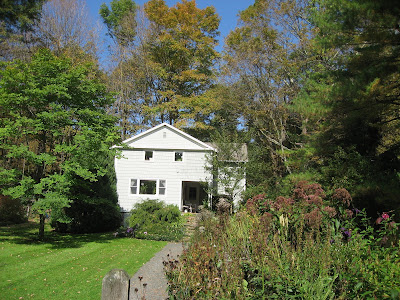
Graves of Betsy and Franklin Ingersoll, Coburn Cemetery, Sherman, CT
In late 19th Century wills, the phrase "married since the 20th Day of April 1877" appears repeatedly. Upon further investigation, I learned that was when Connecticut changed its laws such that husbands no longer automatically gained control of property a wife brought to a marriage. Women became legal entities apart from their husbands and could make contracts etc. This didn't apply to Betsy, who married Franklin Ingersoll in 1828, and over the next 20 years bore him 9 children. Before 1860, they moved with 4 of their children from north of Chapel Hill Road to Hardscrabble Road. Nancy died in 1876.
Franklin remarried, after 1877 but before 1880. This second wife was Nancy Riggs; she may have been the widow of Stephen Briggs. She must have been wealthy; 53 years old in 1880, she and the 73 year old Franklin lived in the TeeVan's house with a couple, the Richmonds, to help with the housekeeping and farm chores.
Nancy died in 1888, Franklin lived two years longer. Because her property was held separately, under the 10 year old law, and because she died without making a will, Franklin's share was half her estate, and her surviving brothers and sisters received the other half. An inventory of the estate was required to make an equitable distribution. This inventory is a window into both the farm and domestic life of Hardscrabble Road.
Only a foundation now exists where a barn once stood. That barn contained not only a horse, hay, robe and blanket, harness, wagon, 2 sleds, 2 plows, a pole tongue, a stone boat, old wagons, a sleigh and an ox breaching and bells, but also diverse tools of farming. A scythe, 2 yokes and flails, a fanning mill, a cutting box, 6 forks and 4 rakes, were also counted. Implements like augers, an anvil, chains, an adz, 3 axes, saws, planes, stone augers, and 6 punch lathes were on hand. Although these were generally part of the man's realm on farms, they were all counted in the inventory of Nancy's personal goods.
The house consisted of no more than 6 rooms, including the kitchen ell. We can imagine how it was furnished. The northern addition probably served as parlor, with an office chair, a parlor rocker, a lounge, a writing desk, a parlor stove and 20 yards of parlor carpet. In the bedrooms there were three bedsteads, 3 straw ticks, 1 feather tick, dutch blankets, blue plaid blankets, 7 pillow cases, 2 quilts, 2 bed pillows and bolsters. There were wash bowls and pitchers and chamber pots with lids.
In the center room and ell were chairs, a center table, a kitchen table, a bureau which contained white china, yellow china, glass dishes, platters, a piece of majolica, teacups, saucers, pie plates and so on.
Kerosene had come into use, there was a can of it. It probably made washing a little less tedious. There were wash tubs and boilers, 21 milk pans and stone (ware) jugs, a tub of lard, a pot of butter, casks of vinegar and cider, barrels of rags and wool. With the 29 fowl in the chicken yard, Nancy's worldly possessions totalled about $322, a third of the value of her real estate, 90 acres and the house and other buildings, valued at $1200.
The latter was sold to the widow Jane Ludington, second wife to Lida's grandfather, John Reynolds Worden, also married since April 20, 1877. When she dies, two years after John R, her property is inherited by her children by her first marriage. It is sold, this time to Lida Beckwith's husband. The two houses are still in the hands of relations. Lida and Burton at the TeeVan house and Lida's father John Henry and his wife Arthilla at Hidden Hollow.
 Part of my hope in searching the deeds at the Sherman Town Hall Vaults was to understand how the dozens of fields enclosed by stone walls were used by 19th residents on Hardscrabble Road. Alas, the vague descriptions of the era, "a pile of stones," " a soft maple tree," combined with nature's changes to the landscape make this difficult.
Part of my hope in searching the deeds at the Sherman Town Hall Vaults was to understand how the dozens of fields enclosed by stone walls were used by 19th residents on Hardscrabble Road. Alas, the vague descriptions of the era, "a pile of stones," " a soft maple tree," combined with nature's changes to the landscape make this difficult.



























